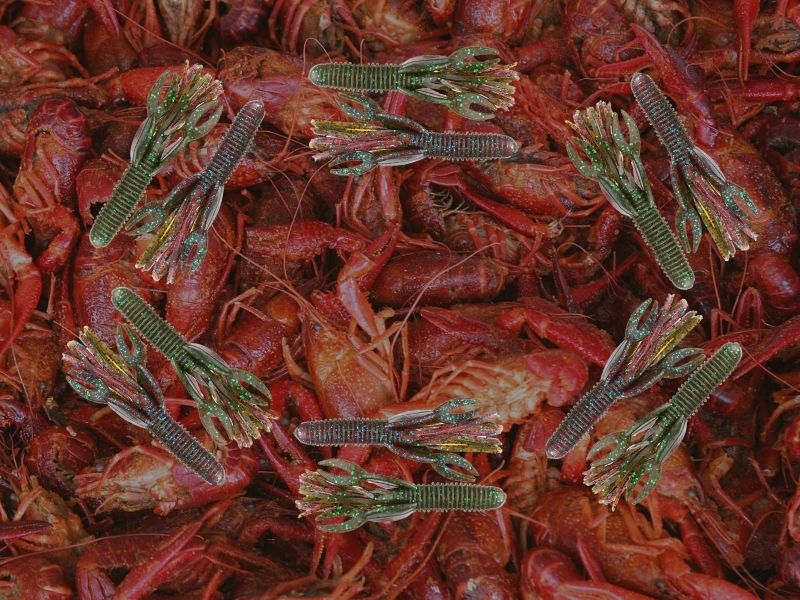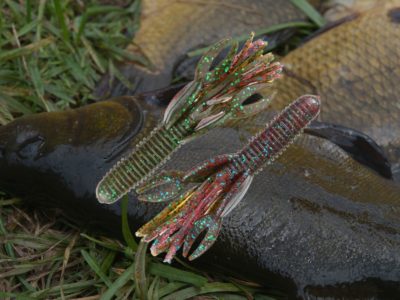All too often, bass anglers overlook tube baits when they’re selecting tackle, which is a shame because these humble baits are often just the thing to fool finicky bass. These chunky baits create a ton of action, and even the most lethargic fish will snap it up when other lures and presentations aren’t doing the trick.
Today, we’ll show you how to fish tube baits and turn you into a tube bait master so you can start leveraging this awesome bait to catch more bass.
Table of Contents
What is a Tube Bait?
Tube baits were invented in the seventies by the Garland brothers, Garry and Bobby, who were meticulous bait makers and excellent anglers in their own right. Their design, the Gitzit, is one that’s still mimicked almost fifty years later by countless makers of soft plastics.
A tube bait is a hollow cylinder of soft plastic with a closed head and a tentacle-like tail. At first, these baits were rigged on a weighted hook or jig head, but as fishing has evolved, anglers have found 101 ways to rig up a tube bait.
The first thing you notice about these things is that they’re fat. Most tubes have a wide diameter making them appear even more appetizing to fish. The circumference of the bait also creates more water disturbance and action for the bait.
While tube baits can prove deadly when using finesse techniques, they’re also an exceptionally forgiving and easy-to-fish bait that is perfect for kids and newbies. Still, seasoned bass anglers know that tubes are an excellent way to spark a bite from fish that have turned their nose at other offerings.
Tube baits come in virtually every color combination imaginable and size for everything from the smallest panfish to the biggest bass. All of the top manufacturers offer a variety of tube bait models, and some are designed for specific rigging methods. Frankly, all of them will catch fish, so it’s mostly a matter of personal preference.
How To Fish a Tube Bait?
Tube baits can be fished in a variety of ways, making them an exceptionally versatile bait you’ll always want to keep in your tackle box.
One of the most popular ways to fish a tube bait is to rig it on a lead head jig and bounce the bait off the bottom as you drift across the surface. This is a tried-and-true method that certainly produces fish, but anglers have found many more productive ways to fish a tube.
You can use this technique from shore, too. By dragging your bait along the bottom, it replicates the look and motion of a crawfish.

Swimming them is one of those methods, and it’s often overlooked. These baits have an erratic action that you can exaggerate with faint twitches of the rod tip, and bass are quick to mistake them for a wounded bait fish. Let the lure sink to the bottom and retrieve the lure at a moderate pace with subtle twitches and see if that doesn’t trigger some action.
Throwing a tube on a drop shot rig is another way to target big bass, and it’s deadly around dock pilings and areas of the structure. Rig the tube on a drop shot, with the hook through the top and out the body, as if you were rigging a grub, and let ‘er rip.
You also can (and should) use tubes when flipping and pitching. Throw a tube onto a flipping hook with a heavy flipping weight, and you have a weedless rig that’s a proven killer when flipped or pitched into heavy vegetation.
Where to Fish a Tube Bait?
There are plenty of instances throughout the year where you’ll find opportunities to fish a tube bait, and we’ve covered some of the most popular scenarios to throw a tube bait in below.
Tubes are also an excellent bait for coercing bedded fish to bite. Rig a tube onto a large 4/0 or 5/0 hook with a weight of up to ½ ounce to ensure your bait stays put on the bottom. Between the look of the tube and the action it produces, even the most lethargic fish have trouble resisting.
If you come across some scattered vegetation on the surface of the water, that’s another excellent opportunity to fish a tube. The fish below use this canopy of grass as shade, and even though they aren’t necessarily on the feed, the presentation of a tube is often too much to resist.
Flipping or pitching a tube around dock pilings is another can’t-miss opportunity when fishing tubes for bass. Avoid pegging your sinker with this presentation, because the weight separating from the bait gives a predator-chasing-prey appearance that’s more likely to trigger a bite from an eager bass.
When to Fish a Tube Bait ?
You can fish a tube virtually all year round, and there are times when they prove especially effective even when you can’t seem to catch a lick with any other lure.
In the late winter and early spring, a tube is an excellent bait to reach for, because it’s a bit softer and more pliable than other plastics, so it isn’t as rigid in cold water as they are. The tentacle-like tail of the tube undulates nicely underwater, and it will trigger strikes because it looks far more realistic than other soft plastics do in cold water.
Tubes are often an excellent bait for targeting post-spawn fish that are in full-on defense mode as they protect their fry. The large shape of a tube looks awful threatening to fish, and defensive bass are quick to snap at it.
The Last Cast
Tube baits are an often overlooked soft plastic, and that’s truly a shame because these baits are exceptionally effective. One of the reasons for their effectiveness is because of how often anglers overlook them. Bass don’t see a ton of them, which is one of the reasons they’re so deadly when fished in the right situations. As always, safety is critical when near a body of water of any kind.
Whether you flip it, pitch it, throw it on a weighted jig head and bump it off the bottom, or any other presentation, rig up a tube on your next trip to the lake. You may be surprised by how well the fish are biting.
Editor’s Picks



